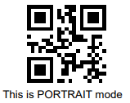Code 128 Settings
Code 128 is a high-density barcode, used for alphanumeric or numeric-only barcodes. It supports all 128 ASCII characters.
Note: To create dynamic barcodes, Metadata options must first have been set (see Meta Data options).
Metadata fields are required to create the association between the dynamic data used in the print run and the barcode.
Use the following options to configure the output Barcode settings:
-
General group:
-
Include in output checkbox: This determines whether of not this Additional Content entry should be included in the output or not.
It is checked by default for all new entries.
This option allow for "libraries" of Additional Content to be created in Presets, libraries from which you can pick and choose what entries you wish to have included, at time of printing. -
Description edit box: An edit box for adding an optional Description to the Additional Content entry.
-
-
Position group:
-
Orientation: Use the drop-down to select the orientation of the Barcode added to the page.
-
Output once per sheet: This option relates to Imposition printing (see Imposition), also known as N-Up printing. Select this box to have the Barcode printed once per sheet rather than once per document page.
Note: If Imposition options such as auto-positioning and scaling were selected, these options won't apply to the Additional Content added to the physical N-Up sheet.
-
Left: Enter the distance between the left margin of the page and the Barcode, in either metric (cm/mm), inch (in) or point (pt) values.
-
Bottom: Enter the distance between the bottom margin of the page and the Barcode, in either metric (cm/mm), inch (in) or point (pt) values.
The orientations would look like this (using text and a QR barcode as the examples), in a Portrait document:
Portrait Landscape Inverse Landscape Inverse Portrait 



-
- Code 128 Properties group:
- Height: Enter the Barcode height in either metric (cm/mm), inch (in) or point (pt) values.
- Module Width: Specifies the width of the narrow bars. Changing this value to a higher value will generally make the Barcode bigger.
-
Print human readable text: Check to add a textual version of the Barcode data.
-
Placement: Use the drop-down to select whether to place the human readable text above or below the Barcode.
-
Font name: Use the drop-down to select the font with which to display the human readable text.
Note: Vertically-oriented fonts (fonts whose typeface name begin with the at (@) character) are not supported in Connect.
-
Font size: Enter a font size for the human readable text.
- Process Tilde:
Check this option to process tilde characters in the data as special characters.
With this option checked, any tilde that needs to be included in the output must be escaped by adding another tilde: ~~.
-
Text: Enter the text used to generate the Barcode.
-
 Add button: Click to display a list of variable data that could be used for generating the Barcode.
Add button: Click to display a list of variable data that could be used for generating the Barcode.
This includes metadata fields which must previously have been added in the Metadata options, likely at the Document Tags level (see Metadata Options), as well as some information fields.
-
-
Condition: Enter the condition which determines whether or not the Barcode will be added to the document at print time. For details on how to create a conditional, see How to set up conditions.
-
 Add button: Click to display a list of metadata fields, information fields to add, or common expressions to the condition.
Add button: Click to display a list of metadata fields, information fields to add, or common expressions to the condition.
-